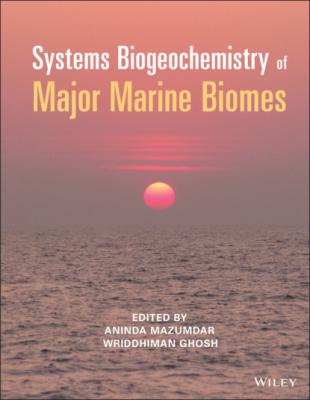Systems Biogeochemistry of Major Marine Biomes. Группа авторов
Чтение книги онлайн.
Читать онлайн книгу Systems Biogeochemistry of Major Marine Biomes - Группа авторов страница 44
 L.R., Sharp, R., Fishbain, S.S. (1996). A freshwater anaerobe coupling acetate oxidation to tetrachloroethylene dehalogenation. Applied Environmental Microbiology 62 (11): 4108–4113.
L.R., Sharp, R., Fishbain, S.S. (1996). A freshwater anaerobe coupling acetate oxidation to tetrachloroethylene dehalogenation. Applied Environmental Microbiology 62 (11): 4108–4113.64 Kurr, M., Huber, R., König, H. et al. (1991). Methanopyrus kandleri, gen. and sp. nov. represents a novel group of hyperthermophilic methanogens growing at 110°C. Archives of Microbiology 156: 239–247. https://doi.org/10.1007/BF00262992
65 Lampa‐Pastirk, S., Veazey, J.P., Walsh, K.A. et al. (2016). Thermally activated charge transport in microbial protein nanowires. Scientific Reports 6 (1): 23517. https://doi.org/10.1038/srep23517
66 Laufer, K., Nordhoff, M., Røy, H. et al. (2016). Coexistence of microaerophilic, nitrate‐reducing and phototrophic Fe(II) oxidizers and Fe(II) reducers in coastal marine sediment. Applied and Environmental Microbiology Environmental Microbiology 82(5): 1433–1447. doi:10.1128/AEM.03527–15
67 Lee, J.S., McBeth, J.M., Ray, R.I. et al. (2019). Iron cycling at corroding carbon steel surfaces. Biofouling 29 (10): 1243–1252. https://doi.org/10.1080/08927014.2013.836184
68 Lemonie, F., Correia, D., Lefort, V. et al. (2019). NGPhylogeny.fr: new generation phylogenetic services for non‐specialists. Nucleic Acids Research 47. doi:10.1093/nar/gkz303
69 Letunic, I. and Bork, P. (2016). Interactive tree of life (iTOL) v3: an online tool for the display and annotation of phylogenetic and other trees. Nucleic Acids Research 44 (W1): W242–245. https://doi:10.1093/nar/gkw290
70 Levar, C.E., Chan, C.H., Mehta‐Kolte, M.G. et al. (2014). An inner membrane cytochrome required only for reduction of high redox potential extracellular electron acceptors. mBio 5 (6): e02034–14. doi:10.1128/mBio.02034–14
71 Li, J., Li, L., Bai, S. et al. (2019). New insight into the biogeochemical cycling of methane, S and Fe above the sulfate‐methane transition zone in methane hydrate‐bearing sediments. A case study in the Dongsha area, South China Sea. Deep Sea Research Part I 145: 97–108. https://doi.org/10.1016/j.dsr.2019.01.011
72 Li, M., Toner, B.M., Baker, B.J. et al. (2014). Microbial iron uptake as a mechanism for dispersing iron from deep‐sea hydrothermal vents. Nature Communications 5: 3192. https://doi.org/10.1038/ncomms4192
73 Li, X., Zeng, X., Qiu, D. et al. (2019). Dissimilatory iron [Fe (III)] reduction by a novel fermentative, piezophilic bacterium Anoxybacter fermentans DY22613T isolated from East Pacific Rise hydrothermal sulfides. Geomicrobiology Journal 36 (4): 291–302. https://doi.org/10.1080/01490451.2018.1526985
74 Liesack, W. and Finster, K. (1994). Phylogenetic analysis of five strains of gram‐negative, obligately anaerobic, sulfur‐reducing bacteria and description of Desulfuromusa gen. nov., including Desulfuromusa kysingii sp. nov., Desulfuromusa bakii sp.nov. and Desulfuromusa succinoxidans sp. nov. International Journal of Systematic Bacteriology 44 (4): 753–758. https://doi.org/10.1099/00207713–44–4‐753
75 Lin, B., Hyacinthe, C., Bonneville, S. et al. (2007). Phylogenetic and physiological diversity of dissimilatory ferric iron reducers in sediments of the polluted Scheldt estuary, Northwest Europe. Environmental Microbiology 9 (8): 1956–1968. doi:10.1111/j.1462–2920.2007.01312.x
76 Lin, T., El Sebae, G., Jung, J.H. et al. (2016). Pyrodictium delaneyi sp. nov., a hyperthermophilic autotrophic archaeon that reduces Fe(III) oxide and nitrate. International Journal of Systematic and Evolutionary Microbiology 66 (9): 3372. doi:10.1099/ijsem.0.001201
77 Liu, H. and Wang, H. (2016). Characterization of Fe(III)‐reducing enrichment culture and isolation of Fe(III)‐reducing bacterium Enterobacter sp. L6 from marine sediment. Journal of Bioscience and Bioengineering 122 (1): 92–96. https://doi.org/10.1016/j.jbiosc.2015.12.014
78 Liu, L., Li, S., Wang, S. et al. (2018). Complex iron uptake by the putrebactin‐mediated and Feo systems in Shewanella oneidensis. Applied and Environmental Microbiology 84 (20): e01752–18. doi:10.1128/AEM.01752–18
79 Lonergan, D.J., Jenter, H., Coates, J.D. et al. (1996). Phylogenetic analysis of dissimilatory Fe(III)‐reducing bacteria. Journal of Bacteriology 178 (8): 2404–2408. doi:10.1128/jb.178.8.2402–2408.1996
80 Lovley, D.R. (2004). Potential role of dissimilatory iron reduction in the early evolution of microbial respiration. In: Origins. Cellular Origin, Life in Extreme Habitats and Astrobiology, Vol 6, (ed. J. Seckback), 299–313. Dordrecht: Springer. https://doi.org/10.1007/1–4020–2522‐X_19
81 Lovley, D.R. (2013). Dissimilatory Fe(III) and Mn(IV) reducing prokaryotes. In: The Prokaryotes (eds. E. Rosenberg, E.F. DeLong, S. Lory et al.), 287–308. Berlin, Heidelberg: Springer.
82 Lovley, D.R. (2017). Electrically conductive pili: biological function and potential applications in electronics. Current Opinion in Electrochemistry 4 (1): 190–198. https://doi.org/10.1016/j.coelec.2017.08.015
83 Lovley, D.R. and Phillips, E.J.P. (1998). Novel mode of microbial energy metabolism: organic carbon oxidation coupled to dissimilatory reduction of iron or manganese. Applied and Environmental MicrobiologyEnvironmental Microbiology 54 (6): 1472–1480.
84 Lovley, D.R., Derek, R., Roden, E.E. et al. (1993). Enzymatic iron and uranium reduction by sulfate‐reducing bacteria. Marine Geology 113 (1–2): 41–53. https://doi.org/10.1016/0025–3227(93)90148‐O
85 Lovley, D.R., Phillips, E.J., Lonergan, D.J. et al. (1995). Fe(III) and S0 reduction by Pelobacter carbinolicus. Applied Environmental Microbiology 61(6): 2132–2138.
86 Lower, B.H., Shi, L., Yongsunthon, R. et al. (2007). Specific bonds between an iron oxide surface and outer membrane cytochromes MtrC and OmcA from Shewanella oneidensis MR–1. Journal of Bacteriology 189 (13): 4944–52. doi:10.1128/JB.01518–06
87 Lower, B.H., Lins, R.D., Oestreicher, Z. et al. (2008). In vitro evolution of a peptide with a hematite binding motif that may constitute a natural metal‐oxide binding archetype. Environmental Science and Technology 42 (10): 3821–3827. https://doi:10.1021/es702688c
88 Lloyd, J.R., Leang, C., Hodges‐Myerson, A.L. et al. (2003). Biochemical and genetic characterization of PpcA, a periplasmic c‐type cytochrome in Geobacter sulfurreducens. Biochemical Journal 369 (1): 159–161. doi:10.1042/BJ20020597
89 Malvankar, N.S., Vargas, M., Nevin, K.P. et al. (2011). Tunable metallic‐like conductivity in microbial nanowire networks. Nature Nanotechnology 6 (9): 573–579. https://doi.org/10.1038/nnano.2011.119
90 Malvankar, N.S., Vargas, M., Nevin, K. et al. (2015). Structural basis for metallic‐like conductivity in microbial nanowires. mBio 6 (2): e00084–15. doi:10.1128/mBio.00084–15
91 Marsili, E., Baron, D.B., Shikhare, I.D. et al.(2008). Shewanella secretes flavins that mediate extracellular electron